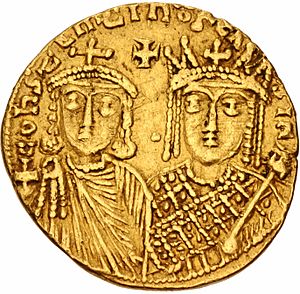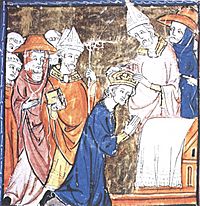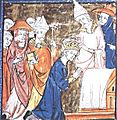Irene of Athens facts for kids
Quick facts for kids Irene of Athens |
|
|---|---|
| Augusta Empress of the Romans |
|
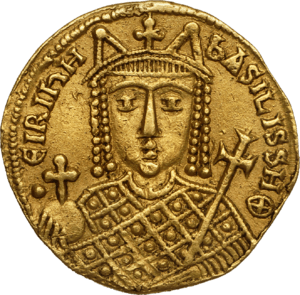
Solidus of Irene issued during her sole reign
|
|
| Byzantine empress regnant | |
| Reign | 19 August 797 – 31 October 802 |
| Acclamation | 15 January 792 |
| Predecessor | Constantine VI |
| Successor | Nikephoros I |
| Byzantine empress consort | |
| Tenure | 775–780 |
| Coronation | 17 December 769 |
| Born | 750–756 Athens, Byzantine Empire |
| Died | 9 August 803 (aged 47–53) Lesbos, Byzantine Empire |
| Spouse | Leo IV |
| Issue | Constantine VI |
| Family | Sarantapechos |
| Dynasty | Isaurian |
| Religion | Chalcedonian Christianity |
Irene of Athens (Greek: Εἰρήνη, Eirénē; 750/756 – 9 August 803) was a powerful Byzantine empress. Her family name was Sarantapechaina. She started as the empress consort (wife of the emperor) to Emperor Leo IV from 775 to 780.
After her husband died, she became a regent for their young son, Constantine VI, from 780 to 790. This meant she ruled the Eastern Roman Empire (also known as the Byzantine Empire) on his behalf. Later, she was a co-ruler with her son from 792 to 797. Finally, she became the empress regnant, ruling the empire by herself, from 797 to 802. This made her the first woman in Roman and Byzantine history to rule as empress in her own right.
Irene came from an important family called Sarantapechos. She was chosen to marry Leo IV in 768, but the reasons are not fully known. Even though her husband was an iconoclast (someone who opposed religious images), Irene supported the use of icons (religious images).
During her time as regent, she called the Second Council of Nicaea in 787. This important meeting decided that iconoclasm was wrong. It brought an end to the first period when icons were banned (730–787). Irene's rule was seen in different ways, as many people thought a woman should not rule alone.
Irene had a lot of influence in the government when her husband was alive. His unexpected death meant she took charge. As her son Constantine grew up, he wanted to rule on his own. Several revolts tried to make him the sole ruler. One of these revolts succeeded, but Irene managed to get her imperial powers back in 792, ruling alongside Constantine.
In 797, Irene planned a plot where her son was severely injured, making him unable to rule. He was imprisoned and likely died soon after. With Constantine out of the way, Irene declared herself the sole ruler. Pope Leo III in Rome used the fact that a woman was ruling the Roman Empire to crown Charlemagne as Holy Roman Emperor on Christmas Day in 800. The Pope claimed that a woman could not rule, so the Roman throne was empty.
A revolt in 802 overthrew Irene. She was sent away to the island of Lesbos. Nikephoros I took her place as emperor. Irene died in exile less than a year later.
Contents
Early Life and Family
Irene was born in Athens, a city in Greece, sometime between 750 and 756. She belonged to the noble Greek Sarantapechos family. This family had a lot of political power in central Greece.
Even though she was an orphan, her uncle or cousin, Constantine Sarantapechos, was an important official called a patrician. He might have also been a military general.
Empress Consort and Regent
Irene arrived in Constantinople, the capital city, on November 1, 769. She married Leo IV on November 3. Her coronation, where she officially became empress, happened on December 17. It is not clear why she was chosen to be Leo IV's wife.
It was unusual because Leo IV's father, Emperor Constantine V, was strongly against icons. Yet, Irene herself supported icons. This has made some historians think she might have been chosen in a "bride-show." This was a process where young women were presented to the groom until one was picked. If true, she would have been the first imperial bride chosen this way. However, there is no strong proof for this idea.
On January 14, 771, Irene gave birth to a son, who would become Constantine VI. He was named after his grandfather, Constantine V. When Constantine V died in September 775, Leo IV became emperor at age twenty-five, and Irene became empress.
Leo IV, like his father, was an iconoclast. However, he was more moderate towards people who supported icons. He removed punishments on monasteries and started appointing monks as bishops. When the head of the church, Patriarch Nicetas I of Constantinople, died in 780, Leo IV chose Paul of Cyprus as his replacement. Paul had iconophile sympathies, but Leo made him promise to uphold iconoclasm.
In early 780, Leo IV's policies against iconophiles became much stricter. He ordered the arrest and punishment of several important court members. This happened after they were found honoring icons.
Ruling the Empire
Leo IV died on September 8, 780. Irene then became regent for their nine-year-old son, Constantine VI. There were rumors that Leo IV died after wearing a special jeweled crown. Irene herself might have spread this rumor to make her late husband look bad.
In October, just six weeks after Leo IV's death, Irene faced a plot. A group of important officials tried to put Caesar Nikephoros, Leo IV's half-brother, on the throne. Irene had the plotters punished and exiled. She replaced them with officials loyal to her. She also made Nikephoros and his four brothers become priests. This meant they could not rule. She forced them to take communion at the Hagia Sophia church on Christmas Day 780. On the same day, Irene wore the crown her husband had removed as part of a full imperial parade.
From the start, Irene seemed to take more power than female regents usually did. Her early coins show both her and her son Constantine VI on the front. They are listed as co-rulers, not just ruler and regent. Also, Irene is shown holding the orb, not Constantine. Only Irene's name is on the front of the coin, while Constantine VI's name is on the back. In all orders, Irene's name came before her son's. She signed orders as empress in her own right. She also did not let Constantine have any say in public matters. Irene knew her position as regent was not secure. Most people probably expected her rule to end quickly and badly, like previous female regents.
Ending the Iconoclasm
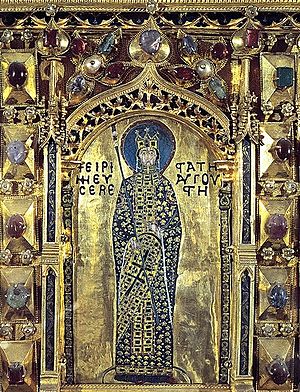
Irene's most important action was bringing back the honoring of icons. Icons are religious images of Christ or saints. In 784, she chose Tarasios, her former secretary, to be the head of the church in Constantinople. She then called two church councils. The first one, in 786, was stopped by soldiers who opposed icons. The second council, held in Nicaea in 787, officially brought back the veneration of icons. This also reunited the Eastern church with the church in Rome. This event is known as the Seventh Ecumenical Council.
This greatly improved relations with the Pope. However, it did not stop a war with the Franks, who took over some areas in 788. Despite these problems, Irene's military efforts had some success. In 782, her trusted official Staurakios brought the Slavs in the Balkans under control. This helped the Byzantine Empire expand in that area. Still, Irene was often bothered by the Abbasids, a powerful Islamic empire. In 782 and 798, she had to agree to pay a yearly tribute to their leaders, Al-Mahdi and Harun al-Rashid.
Power Struggles and Sole Rule
As Constantine grew older, he became restless under his mother's strong rule. Even though Constantine VI was old enough to rule, Irene continued to manage the state. She was the true ruler of the Romans. Constantine no longer accepted being second. He tried to take power by force. But Irene stopped him. She demanded that everyone swear loyalty only to her. Irene also tried to convince the army to accept her as the absolute ruler.
The unhappiness this caused led to open resistance in 790. Soldiers, led by the army of the Armeniacs, officially declared Constantine VI the sole ruler. To try and bring order back, Constantine, pretending to be friendly, gave Irene her titles back. He confirmed her position as ruler on January 15, 792. This started the Irene-Constantine co-rule.
However, the rivalry continued. Irene's group, led by her powerful minister Staurakios, returned to power. They began to get revenge on anyone who had opposed them. In 797, Irene, through clever plans with nobles, officers, bishops, and courtiers, organized a plot against Constantine. He tried to escape to the provinces for help, but even there, people involved in the plot threatened him. His own attendants, who were loyal to his mother, captured him. Constantine was brought back to the palace in Constantinople and was severely injured on August 19. It is not known if he survived this event.
It is often said that Irene called herself "basileus" (emperor) instead of "basilissa" (empress) when she ruled alone. However, there are only a few cases where she definitely used the title "basileus." These include two legal documents and one gold coin. In all other documents, coins, and seals, she used the title "basilissa."
Relations with the Carolingian Empire
Irene's unique position as an empress ruling alone happened at the same time as the rise of the Carolingian Empire in Western Europe. This new empire, led by Charlemagne, was a rival to Irene's Byzantine Empire in size and power. Charlemagne had conquered parts of Italy and campaigned against tribes in Germany. He also defeated the Avars in Central Europe.
Charlemagne was crowned Emperor by Pope Leo III on Christmas Day, 800. The church leaders and nobles at the ceremony called Charlemagne "Augustus." Some people argued that the imperial position was empty because a woman was not fit to be emperor. However, Charlemagne did not claim to rule the Eastern Roman Empire. The Eastern Empire felt its role as the only true Roman Empire was threatened. It began to emphasize its superiority and its Roman identity. Relations between the two empires remained difficult. It is said that Irene tried to arrange a marriage between herself and Charlemagne, but this plan was stopped by one of her favorite officials.
Overthrow and Death
In 802, important officials plotted against Irene. They removed her from power on October 31. They put Nikephoros, the minister of finance, on the throne instead. Irene was sent away to the island of Lesbos. She was forced to support herself by spinning wool. She died the next year, on August 9.
Legacy
A female relative of Irene, Theophano, was chosen in 807 to marry Emperor Nikephoros I's son and heir, Staurakios.
Irene's strong efforts to bring back icons and support monasteries led Theodore the Studite to praise her as a saint. She is remembered by Byzantine Catholic and Eastern Orthodox Christians on August 7.
Media
H. Rider Haggard included Irene as a villain in his novel The Wanderer's Necklace.
Images for kids
-
Refusing to recognize Irene's reign, Pope Leo III crowned Charlemagne as Holy Roman Emperor.
See also
 In Spanish: Irene de Atenas para niños
In Spanish: Irene de Atenas para niños


